|
Beyond
"cut and paste" -- what other photo tricks did Duchamp use?
|
click
to enlarge
|
|
|
|
Illustration
40A.
|
|
Known Stieglitz
version of Duchamp's Fountain urinal published in Blindman
No. 2,1917
|
|
|
|
Illustration
40C.
Examine the
circled area in illustration 40C. The indefinite shadows and discontinuous
lines and edges indicate this lower left corner as a likely site
of photographic compositing and retouching.
|
As previously described,
I had suspected that the Stieglitz partial urinal photo represented
a step in Duchampís photo compositing process, and that this photographic
part, was itself, perhaps, made of photo parts. Illustration 40B suggests
that, indeed, the drain holes were added within the Stieglitz partial
photo, which, as a subtle but visible vestige, remains in the original
Stieglitz photo, see illustration 40A.
|
click
to enlarge
|
|
|
|
Illustration
40B.
When the contrast
of light and shadow are amplified, the drain holes reveal a distinct
boundary that is, unexpectedly, and without apparent reason, lighter
in value and gives the literal appearance of having been added
as a patch.
|
Note that in illustration
40B, when the contrast of light and shadow are amplified, the drain
holes reveal a distinct boundary that is, unexpectedly, and without
apparent reason, lighter in value, thus giving the literal appearance
of having been added as a patch.
The urinal in the
Stieglitz photo, shown close up and large, created a greater technical
challenge for hiding alterations than in our previous examples of the
hatrack or coatrack, that are depicted as farther away and small, and
therefore creating less expectation of perceiving visible detail. Since
hatracks and coatracks are, literally, made of parts (the hooks and
wood base are all physical parts put together), photographic cutting
and pasting of parts can naturally exploit these predetermined and expected
joinings, whereas, the urinalís smooth and continuous, singular form
does not offer such easy opportunities.
Illustration 40C depicts
yet another important piece among numerous pieces of evidence (pun intended).
Porcelain urinals are molded forms that produce clean, clearly unambiguous
lines and edges as shown in illustration 40D, E, F, (depictions of Bedfordshire
type urinals taken from Mott, Crane and Trenton Potteries catalogues
of the period [circa 1917]). Examine the circled area in illustration
40C. The indefinite shadows and discontinuous lines and edges suggest
this lower left corner as a likely site of photographic compositing
and retouching
| Click
each image to enlarge |
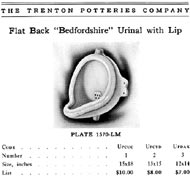 |
|
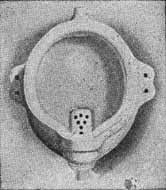 |
|
Illustration
40D.
Trenton Potteries
|
Illustration
40E.
Mott
|
Illustration
40F.
Crane
|
| Three
different company catalogue entries (circa 1917) featuring the same
urinal type that looks most like Duchampís urinal |
We are presently working,
along with forensic experts, on a substantial list of other oddities
found within the Stieglitz photo (40A) including: (1), more precise
determination of the nature of the distortions, first noted by William
Camfield, between the urinal in the foreground as depicted in relation
to the painting in the background. We will also analyze and try to relate
the seemingly strange scale differences among objects in the Stieglitz
photo; such as the size of the urinal itself in comparison to the gauge
of the string tied to the left "ear-bracket"; or the relatively
too large appearance of the rough hewn texture of the wood pedestal;
(2), testing the feasibility of placing the urinal (whose actual form,
not shown, is hollowed out underneath) so off center on the pedestal,
as depicted on the photo; and (3), studying the strange shadows, lighting,
as well as the peculiar reflections (reminiscent of pooling urine),
in the top upper lip of the urinal -- a pooling that appears to be defying
gravity. (If these reflections were actually urine, we would have to
be standing above, strattling a normally installed urinal in a novel
orientation -- with our backs against the wall looking down into the
pool of urine and facing out to whoever would be peeing.)
|
click
each image to enlarge
|
|
|
|
|
Illustration
41A.
|
Illustration
41B.
|
|
Two
Photographs of Duchamp's studio taken in 1916-17
A common but more difficult method of combining photo parts depends
upon the use of a dark or black background (cardboard or cloth)
placed into a scene and a corresponding space left blank on the
photographic plate in the camera.
© 2000 Succession Marcel Duchamp, ARS, N.Y./ADAGP, Paris
|
A second compositing
method, beyond cut and paste, is suggested within the two studio photo
depictions of Duchampís urinal, see illustrations 41A, B, C, D. A common
but more difficult method of combining photo parts uses a dark or black
background (cardboard or cloth) placed into a scene with a corresponding
space left blank on the photographic plate in the camera. In this blank
space, a second image (not in the immediate scene) can then be seamlessly
added into both the plate, and also into the (formerly) plain black
background.
Illustrations 42A,
B, C, D show a few early examples from a 1898 book written
|
click
each image to enlarge
|
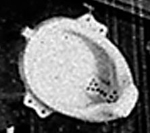 |
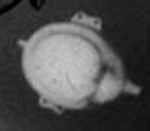 |
|
Illustration
41C.
|
Illustration
41D.
|
|
Close-up
views of the Duchampís studio photographs (41A and 41B) Carefully
note the general blackened area behind the urinal in illustration
41B and 41D and the dark cloth hanging directly behind the urinal
in illustration 41A and 41C.
|
for the general public,
and titled, Magic; Stage Illusions, Special Effects and Trick Photography.
Compare these four illustrations to illustrations 41 A, B, C, D, Duchampís
two studio photos that depict his urinal. Carefully note the general blackened
area behind the urinal in illustration 41B and 41D and the dark cloth
hanging directly behind the urinal in illustration 41A and 41C. Not only
do the other photo alterations, as previously discussed, exist in these
two studio depictions (remember, the ghost figure in 41A and the likely
cutting and pasting of the hatracks and shovels in 41A and B) but the
urinal appears to be "applied" to the scene using the classic
black background composite technique as the device. Look at our animation
analysis in illustration 43A and 43B.
|
click
each image to enlarge
|
|
|
|
|
|
|
Illustration
42A.
|
Illustration
42B.
|
Illustration
42C.
|
Illustration
42D.
|
|
Four
19th century examples of the "black ground method" of
compositing
multiple photographic images taken at differnet distances
|
The
irregular shadowing, unsure line and edges of the urinalís silhouette
(especially prominent in 43A) indicate a careful but, imperfect, masking
and transfer of the urinal onto the blackground placed in the scene.
Note, in the animation, that the studio depictions of the urinalís interior
lip shape, when outlined, comes very close to matching the form of our
standard Crane/Mott/Trenton Potteries Bedfordshire model; whereas form
of the interior lip on the ideal Stieglitz urinal (that is, when the
drain and pipe holes are corrected to be centered) is very different,
see animation 43C. Of course, these data conform with my prediction
(derived from my hypothesis) that the two studio photos are slightly
altered representations of an actual Bedfordshire urinal (and, therefore,
that a Bedfordshire model would predictably almost match.) However,
a 3D model -- even a corrected one -- based upon the geometry in Stieglitz
photo would not match either the two studio photo urinals or the Bedfordshire
model. As I have argued, the Stieglitz image is not representing, factual
urinal different from either the 2 studio urinals or Bedfordshire model.
I believe that the Stieglitz urinal is a photo composite made
of varied parts taken from photographs of an actual Bedfordshire
3D urinal from different perspectives and at different scales).
|
click
each image to see animations
Animations by Gregory
Alvarez and Rhonda Roland Shearer
|
|
|
|
|
|
Illustration
43A.
|
Illustration
43B.
|
Illustration
43C.
|
|
Video
of Urinal animation analysis that compares the 3D Crane model
to the Stieglitz model and this studio photo
|
Video
of Urinal animation analysis that compares the 3D Crane model
to the Stieglitz model and this studio phtot
|
Video of
Urinal animation analysis that compares the Stieglitz photograph,
the corrected ideal shape and a 3D model (made with depicted distortions)
are compared.
|
|
click
each image to enlarge
|
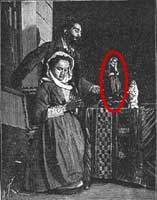 |
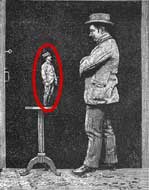 |
|
Illustration
44A.
|
Illustration
44B.
|
|
Compositing
separate images can play with scale with use of multiple images
of the same figure taken at two different distances. Magic
Stage Illusions, Special Effects and Trick Photography, Albert
A. Hopkins (ed.), 1898, p. 426, 430
|
Looking back at the
historical examples of the black background method of photo compositing,
in 42C and D (now circled and labeled as illustrations 44A and 44B),
we see how the compositing of separate images can play havoc with scale
(when we see multiple images of the same figure taken at two different
distances, we interpret these figures in the final photograph as small
and large sizes.) Other cues reinforce our interpretation of small and
large figures standing side by side (as opposed to the small figure
suggesting greater distance, and the larger figure as the same size
standing in the foreground). In illustration 44B, for example, the tableís
position in space (directly opposite to the larger standing figure),
along with the feet of the small figure physically happening to meet
the tableís horizontal plane, immediately evokes our most absurd and
impossible interpretation -- a real Tom Thumb!
According to forensic
experts, the only way to get a better grasp on why and how the scales
of urinal parts, and other objects in the Stieglitz photo look out of
whack, is to determine as much as possible about actual sizes. For example,
how large are the tags used at the 1917 Exhibition? (see illustration
45A, of the Stieglitz photo with its tag circled.) The urinal looks
disturbingly small in comparison to the string, hang tag, and wood pedestal
texture. We have already determined, by our prior analysis, that the
"ear-brackets" as depicted in the Stieglitz photo appear too
large when compared to the actual Bedfordshire models of the period.
Perhaps the ear-bracket [with the string and tag] are from a single
photo taken at a different distance, a photo that was then fused with
the rest of the urinal parts?)
Moreover, our forensic
expertís initial analysis echos my suspicion that the urinals in the
two studio photos (45B, 45C) are, in addition to our sense that the
scale of the urinalsí size is off, in comparison to the rest of the
room, most likely composited in, and also do not seem to hang according
to gravity, (We need to try to measure Duchampís old studio room. If
any original woodwork exists, we can learn a lot more about Duchampís
photos.)
|
click
each image to enlarge
|
|
|
|
|
|
Illustration
45A.
|
Illustration
45B.
|
Illustration
45C.
|
|
Perhaps
the ear-bracket [with the string and tag] are from a single photo
taken at a different distance which was then fused along with
the rest of the urinal parts.
|
The
two urinals appear applied upon
black backgrounds and seem to not
hang according to gravity.
|
|